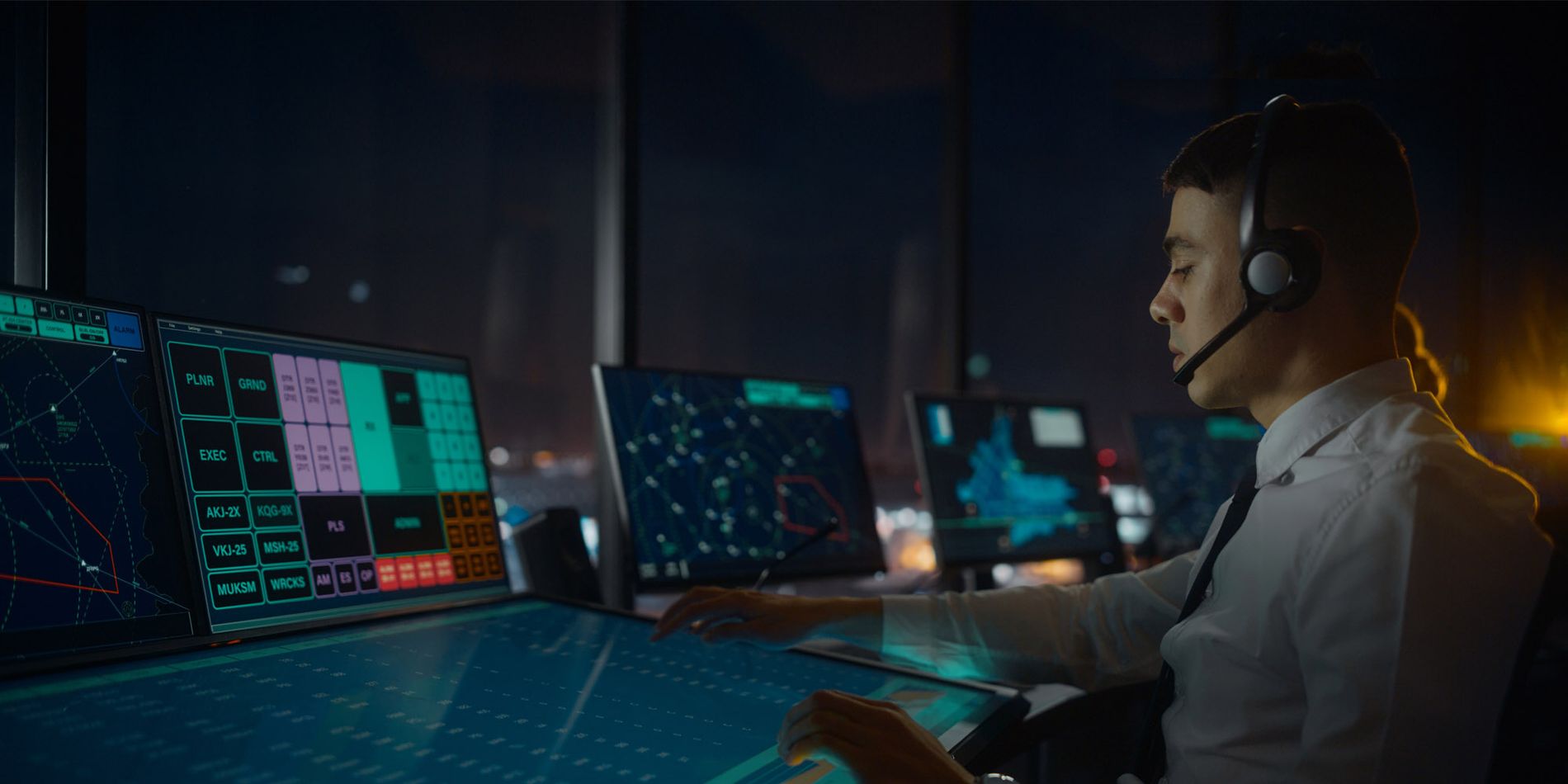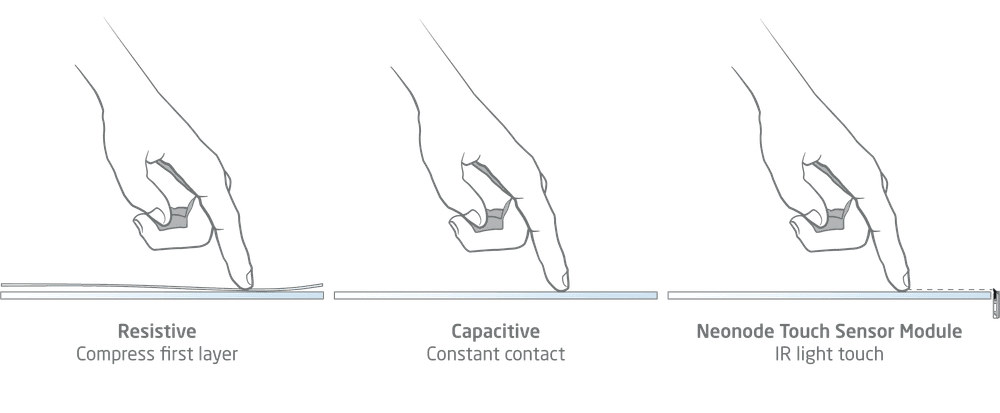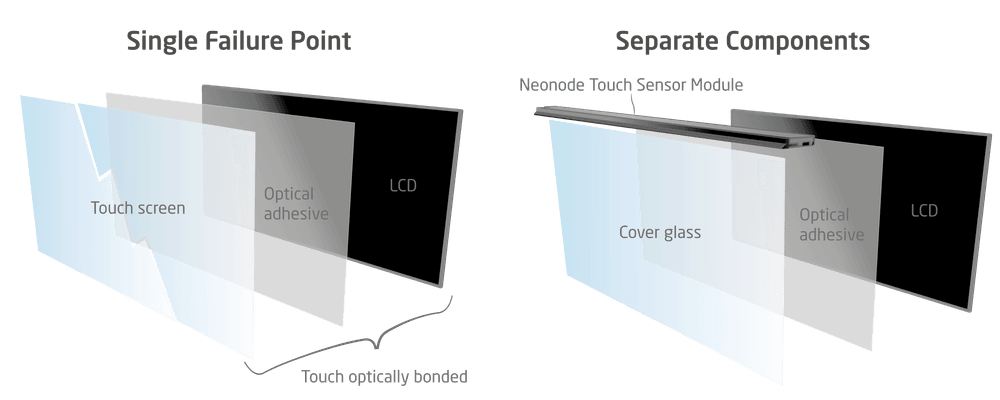Cookie-Einstellungen

Vereinfachte Touch-Integration mit dem einseitigen Sensor
Wenn es darum geht, Touch-Funktionen in kommerzielle Produkte zu integrieren, sind Optionen in Verbraucherqualität nicht immer die beste Wahl. Mit einem einzigen Sensor ermöglicht Neonode Herstellern die Entwicklung von Touch-Oberflächen mit höherer Zuverlässigkeit und besserer Optik, selbst unter rauen und robusten Bedingungen.
Touchscreens sind keine Neuheit mehr, sondern in Tausenden von Alltagsgeräten wie Mobiltelefonen, Tablets und Haushaltsgeräten alltäglich. Da die Berührungsschnittstelle im Alltag so alltäglich geworden ist, hat die Berührung auch ihren Weg in viele nicht so alltägliche Anwendungen gefunden, wie z. B. Bildschirme auf dem Schlachtfeld, industrielle Maschinensteuerungen, landwirtschaftliche Geräte, Luftfahrtelektronik und sogar Raumfahrzeugen. Die meisten Produktentwicklungsingenieure sind daher mit den Vor- und Nachteilen von Touchtechnologien bestens vertraut, insbesondere im Fall von projizierten kapazitiven und resistiven Berührung Technologien. Diese Technologien sind sehr ausgereift und haben sich erheblich weiterentwickelt. Sie sind im Preis gesunken, während sich Leistung und Funktionalität verbessert haben.
Die Fortschritte in der Technologie wurden jedoch hauptsächlich durch die Verwendung in der Unterhaltungselektronik vorangetrieben, und daher wurde die Technologie für den Verbrauchermarkt optimiert. Die kapazitive Berührung ist in unseren Lieblingsgeräten recht gut und wir leben mit einigen der nicht so perfekten Nachteile. Der Einsatz dieser Technologien in industriellen und gewerblichen Anwendungen ist jedoch nicht immer sinnvoll.
In der Tat sind kommerzielle Geräte oft durch die Verbrauchertechnologie eingeschränkt und benötigen zusätzliche Verbesserungen, um in der Umgebung zu funktionieren, in der sie eingesetzt werden sollen. In diesem Fall steht den Display-Integratoren eine Reihe von Werkzeugen zur Verfügung, um die Verbrauchertechnologie für kommerzielle und industrielle Anwendungen anzupassen. Dazu gehören EMI-Abschirmung und Dichtungen zur Isolierung des kapazitiven Feldes und Verstärkungsfolien, optisches Bonding und verstärkte Hintergrundbeleuchtung, um die Auswirkungen der ITO-Beschichtungen auf die Optik auszugleichen. All diese Lösungen haben jedoch Nachteile, die sich vor allem in einer geringeren Leistung, einer schlechteren Optik und einer geringeren Benutzerfreundlichkeit niederschlagen, während gleichzeitig die Komplexität der Integration und die Kosten steigen.
Es gibt noch eine andere Möglichkeit.
Wie wäre es, wenn Sie einfach einen dünnen, nur 3 mm dicken Sensor an einer Seite des Displays anbringen und eine Touch-Oberfläche schaffen könnten, die keine zusätzlichen Montageschritte, kein optisches Bonding, keine Abschirmung, keine Abstimmung und keine Kalibrierung erfordert?
Wie wäre es, wenn Sie eine bündige Oberfläche beibehalten könnten, um der Designästhetik gerecht zu werden und gleichzeitig eine Oberfläche zu bieten, die leicht zu reinigen ist und vor Oberflächenverunreinigungen schützt?
Wie wäre es, wenn Sie Polycarbonat als Vandalismusschutz verwenden könnten? Und wie wäre es, wenn Sie das Display vom Berührungssensor trennen könnten, um einen einfachen Austausch vor Ort zu ermöglichen, für den Fall, dass ein Schwachkopf das Display mit einem Baseballschläger trifft?
Was wäre, wenn Sie eine einzigartige Displaygröße anbieten könnten, ohne Hunderttausende von Dollar für NRE-Kosten und MOQs ausgeben zu müssen? Was wäre, wenn Sie einzigartige Displaygrößen anbieten könnten, um z. B. ein resistives 20x8-Flugzeugdisplay nachzurüsten oder einen 4:3-Röhrenbildschirm durch einen Touchscreen-LCD-Bildschirm in kleinen Stückzahlen zu ersetzen?
Wovon reden wir also? Die Technologie heißt Neonode zForce® Sie basiert auf der Nutzung von Infrarotlicht, aber anstatt nach blockiertem Licht zu suchen, wie es bei herkömmlichen Infrarotrahmen der Fall ist, nutzt sie die Reflexion. Die Neonode zForce ist in unseren kostengünstigen Touch-Sensor-Modulen untergebracht, die selbst in den schwierigsten Umgebungen funktionieren.
Was sind die Vorteile?
Leichte Integration:
Eines der größten Probleme bei der Integration kapazitiver Sensoren ist das kapazitive Feld - das Gleichgewicht zwischen verbesserter Erkennung und der Erzeugung von mehr Rauschen oder der Beeinträchtigung durch elektrisches Rauschen. Das ist knifflig. Zu den Lösungen gehören Folien, Dichtungen und noch mehr ITO-Beschichtungen. All diese Maßnahmen kosten Geld und Zeit und verursachen zusätzlichen Aufwand bei der Entwicklung und Montage. Das bedeutet auch, dass ein kapazitiver Sensor nicht einfach während der Montage in ein Gehäuse integriert werden kann, ohne dass man erwarten kann, dass er ohne zusätzliche Tüfteleien funktioniert.
Das Neonode Touch Sensor Module wird durch elektrisches Rauschen nicht beeinträchtigt und kann direkt auf Metalloberflächen, einschließlich der Blende und der Seite des LCD-Gehäuses, angebracht werden. Es ist keine Abstimmung oder Abschirmung erforderlich.

Ein weiterer Vorteil ist das Touch Sensor Module selbst. Es ist vollständig eingeschlossen und kommt ohne einen separaten Controller aus. Es besteht keine Notwendigkeit, einen akzeptablen Platz für den Controller im Displaystapel zu finden, da der Sensor selbst die für seinen Betrieb erforderliche Elektronik enthält.
Die Standardschnittstelle funktioniert sofort als USB-HID-Schnittstelle oder als eingebettete Schnittstelle wie I2C.
Bessere Optik:
Resistive und kapazitive Sensoren bestehen aus Schichten von Materialien und Beschichtungen, die die Lichtleistung der Hintergrundbeleuchtung verringern. Diese Beschichtungen verzerren auch Bilder und reflektieren sogar Licht zwischen den Schichten, was die Anzeige weiter verschlechtert. Zwar wurden die Lichtdurchlässigkeit und die optischen Beschichtungen erheblich verbessert, aber es handelt sich immer noch um eine weitere Schicht, die Bilder entfernt, verzerrt und sogar farblich verschiebt. Darüber hinaus wird die verbesserte Optik dieser Sensoren durch optisches Bonding erreicht, bei dem zwei zuvor unabhängige Teile zu einer Fehlerstelle verschmolzen werden.
Das Touch Sensor Module wird an einer beliebigen Seite des Displays angebracht und beeinträchtigt in keiner Weise die Qualität des Displays. Keine zusätzliche Schicht bedeutet eine höhere Lichtausbeute der Hintergrundbeleuchtung, was Strom spart und die Wärmeentwicklung reduziert. Es bedeutet auch keine Beeinträchtigung der Display-Optik.
Verbesserte Benutzerfreundlichkeit:
Kapazitive Sensoren benötigen einen Pfad zur Erde, um Berührungen zu registrieren, und in den meisten Fällen ist dies der bloße Finger. Mit Handschuhen funktioniert das mit der richtigen Einstellung, aber das geht mit einer geringeren Genauigkeit oder zusätzlichem Rauschen einher. Resistive Sensoren hingegen erfordern eine Kompression der oberen Schicht, um Berührungen zu erkennen. Beides ist nicht ideal für reibungslose Wisch- und Ziehvorgänge.

Die Neonode-Touch-Sensormodule haben eine Erfassungshöhe von unter einem Millimeter auf der Oberfläche des Displays. Dies bedeutet, dass Ziehvorgänge intuitiv und reibungslos ablaufen, da sie mehr verzeihen und keine Kompression oder ständige Berührung erfordern, um Ihren Finger zu verfolgen. Dadurch werden Funktionen wie flüssiger Bildlauf und Navigation verbessert.
Robustheit:
Die meisten Touchscreen-Overlays bieten nur sehr wenig Vandalismusschutz für das Display, da sie nur so dünn wie möglich sind, um die Optik zu verbessern. Die Dicke des Glassubstrats, durch das die projizierte Kapazität wirken kann, ist begrenzt, und es wird ein dünnes Stück Glas oder Polycarbonat als erste Oberfläche verwendet. Noch schwieriger wird es, wenn der Sensor zur Verbesserung der Optik auf das Display geklebt wird, denn dann lassen sich die beiden Komponenten nicht so leicht voneinander trennen, und man hat zwei teure Komponenten, die ersetzt werden müssen.

Die Neonode-Touchsensormodule werden am Rand des Displays platziert und sind unabhängig vom Display. Das bedeutet, dass die Konstrukteure ein beliebiges Substrat zum Schutz des Displays wählen können. Sollte es beschädigt werden, kann das Overlay vor Ort ausgetauscht werden, ohne dass das LCD ausgetauscht oder der Touchscreen neu kalibriert werden muss.
Extreme Umgebungen:
Analoge Touchscreens reagieren auf Temperatur-, Feuchtigkeits- und Druckschwankungen. Auch hier wurden enorme technologische Verbesserungen erzielt, aber je größer das Display ist, desto mehr wird dies zu einem Problem. Touchscreens bevorzugen angenehme Umgebungen und beginnen in extremen Umgebungen zu leiden, was bedeutet, dass Berührungssymbole falsch ausgerichtet werden können oder Berührungspunkte nicht erkannt werden.
Neonode Touch Sensor Module sind optisch. Sie sind unempfindlich gegenüber Temperatur-, Feuchtigkeits- oder Druckschwankungen. Die Sensormodule können mit einer dünnen, nur wenige Millimeter hohen Abdecklinse gegen Staub und Wasser abgedichtet werden, die in den Rahmen integriert wird und die Montage vereinfacht.
Einzigartige Funktionalität
Berührungslose Berührung - Nach COVID sind wir immer noch besorgt über Oberflächenverunreinigungen und öffentliche Touch-Displays können eine Quelle für Krankheitserreger sein. Da der Sensor parallel zur Oberfläche des Displays verläuft, kann er in beliebigem Abstand über dem Display angebracht werden, um eine Interaktion in der Luft zu ermöglichen, ohne den darunter liegenden Bildschirm zu berühren. Er kann auch in Verbindung mit anderen Berührungssensoren verwendet werden, um sowohl Oberflächen- als auch Nicht-Oberflächen-Berührungsoptionen anzubieten.
Sensor-Fusion - Unter Sensorfusion versteht man die Kombination mehrerer Sensoren zur Verbesserung der Funktionalität. Beispiele hierfür sind:
Aufwachen bei Annäherung - Einige Anwendungen nutzen den Wake-on-Ansatz, um den Inhalt z. B. vom Werbemodus auf ein Bestellmenü umzuschalten. Eine andere Implementierung könnte Icons vergrößern oder mehr personalisierte Inhalte basierend auf der Nähe zum Display präsentieren. Das Neonode Touch Sensor Module kann verwendet werden, um die Berührungsabsicht aus beliebiger Entfernung von der Oberfläche zu erkennen, was es Designern ermöglicht, den Anzeigemodus basierend auf der Berührungsabsicht zu ändern.
Redundanz - Einsatzkritische Anwendungen benötigen Back-up-Systeme, um den Betrieb wichtiger Funktionen zu gewährleisten. Unter militärischen Avionikkönnten Touch-Displays angeboten werden, die über zwei unabhängige Touch-Schnittstellen verfügen. Zum Beispiel könnte man den alten resistiven Touchsensor beibehalten und ein Backup-System mit einem Touch Sensor Module hinzufügen. Beide können ein- und ausgeschaltet werden oder zusammenarbeiten und so ein nahtloses Backup-System bieten, falls der herkömmliche Touchsensor nicht mehr funktioniert.
Bestätigung der Berührung - Unbeabsichtigte Berührungen können ärgerlich sein oder sogar katastrophale Folgen haben, je nach Anwendung. Keine Touchscreen-Technologie ist narrensicher, aber Berührungen werden immer noch in einigen anspruchsvollen Anwendungen eingesetzt, die eine genaue Anzeige der Interaktivität benötigen. Da kapazitive Sensoren Berührungen auf eine ganz andere Art und Weise erkennen als Touch Sensor Module, können die beiden Sensoren zusammen verwendet werden, um zu bestätigen, dass eine Berührung registriert wurde, um z. B. eine Geisterberührung durch eine EMI-Streuquelle in einem medizinischen Diagnosegerät aufzulösen.
Zugegeben, für Anwendungen, bei denen Sie einen kapazitiven Sensor verwenden können, werden Sie wahrscheinlich einen kapazitiven Sensor verwenden. Aber in Fällen, in denen Sie mit Handschuhen arbeiten müssen oder kein elektrisches Rauschen tolerieren können (z. B. medizinische Diagnostik) oder für Anwendungen, die in einer unbeaufsichtigten Umgebung funktionieren müssen, ist ein kapazitiver Sensor möglicherweise nicht die beste Wahl. Eine Alternative für diese Anwendungen ist ein Neonode Touch Sensor Module. Es kann am Rand des Bildschirms angebracht werden, was die Integration vereinfacht, die Optik des Bildschirms schont, die Leistung verbessert und einzigartige Funktionen bietet, die andere Berührungssensoren nicht bieten können, wie Redundanz, Berührungsbestätigung und Aufwachen bei Annäherung.
Download Touch Technology for Commercial Applications Brochure